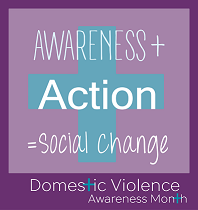National Domestic Violence Awareness Month
By: Lia Holbrock
October is National Domestic Violence Awareness Month. Each October, communities across the nation embrace the opportunity to deepen our understanding and connect with those who work to end violence across the globe. Though domestic violence is often still viewed as a “private matter”, it has devastating ripple effects across our society. In the United States, an average of 20 people experience intimate partner physical violence every minute. This equates to more than 10 million abuse victims annually. In just one day, across the US and its territories, National Network to End Domestic Violence (NNEDV), Census Counts for 2011 reported more than 67,000 victims of domestic violence sought services from domestic violence programs and shelters. (National Network to End Domestic Violence, 2012) Abuse can affect families and communities across generations and can occur in all types of relationships---casual dating, married/separated couples across the lifespan, and between children and parents. Domestic violence affects individuals in every community regardless of age, race, religion, financial status, sexual orientation, gender identity, and education. Domestic violence is a pattern of controlling and coercive behavior that can include physical, sexual, financial, verbal, or emotional abuse.
Domestic violence does not only impact the couple; if there are infants, children, and/or teens in the home, the exposure can have lasting effects. The Centers for Disease Control and Prevention have reported that in homes where violence occurs between partners, there is a 45% to 60% chance of co-occurring child abuse---a rate 15 times higher than the average. Even when not physically impacted, children witness 68% to 80% of domestic assaults. Those who are not direct victims have some of the same behavioral and psychological problems as children who are physically abused. (World Health Organization, 2002) Witnessing violence between one’s parents or caretakers is the strongest risk factor of transmitting violent behavior from one generation to the next, either as a victim or a perpetrator. (Break the Cycle, 2002)
Contrary to popular belief, infants and small children who are exposed to violence in the home are particularly vulnerable. In these early stages of development, neural connections are laying the groundwork for how to self-sooth and form relationships. Trauma in this time frame can significantly impact the make-up of the brain. Studies show the impact not only on brain development, but also on a child’s ability to forms attachments, self-regulate, and cognate. Children who are exposed to violence in the home need trusted adults to turn to for help and comfort, and services that will help them to cope with their experiences.
As recognition of the impact of domestic violence on children increases, it becomes more important for domestic violence advocates and other practitioners to create interventions that decrease or prevent the harms associated with exposure to violence. Building protective factors for children exposed to domestic violence can help increase resilience and promote skills, characteristics, relationships, and opportunities that offset risk factors and contribute to improved wellbeing. Prevention efforts should start early by promoting healthy, respectful relationships in families by fostering healthy parent-child relationships and developing positive family dynamics and emotionally supportive environments. (Black M. B., 2011) As a community, we must support services that address protective factors such as: individual and/or group counseling for children exposed to domestic violence, skill building around emotional regulation and problem solving for kids, supports for parents of children exposed to domestic violence, and programs focused on improving parenting competencies and parental wellbeing.
Strategies to prevent domestic violence can effectively strengthen the health of our communities. Preventing violence means changing our society and its institutions—eliminating those attitudes, beliefs, behaviors, environments and policies that contribute to violence and promoting those that stop the violence. (The Missouri Coalition Against Domestic & Sexual Violence. (March 2012). Embracing prevention as social change: How to build organizational capacity for prevention. Jefferson City, MO.) Prevention work can begin and the individual level. Starting is simple. If you are concerned about the effects of violence in your community, begin the conversation with those in your life.
Here are a few tips on informed conversations:
- Challenge widely-held perceptions about domestic violence. Unfortunately, misconceptions about domestic violence persist – such as the notions that survivors can “just leave”. Survivors must think about their own physical safety, financial security, the safety and welfare of their children and pets, potential housing, among myriad other issues.
- Listen! Survivors know their experience and story better than anyone. Ask survivors what they need to individually be safe – there is no one-size-fits-all approach to addressing domestic violence.
- IF YOU’RE HAVING A CONVERSATION ABOUT DOMESTIC VIOLENCE AND SOMEONE DISCLOSES THAT THEY ARE A VICTIM OR SURVIVOR OF DOMESTIC VIOLENCE, YOU CAN: Listen, and communicate that the abuse they’re experiencing is not their fault. Let them know that they deserve safety and respect.
REFER TO RESOURCES: If they are in immediate danger, please call 911, our local helpline at (Inland-463-4357), (Coast 964-4357). Or refer them to one of our office locations:
564 S. Dora St, Ukiah (707) 462-9196
461 N. Franklin Street, Fort Bragg (707) 961-1507
175 Main St, Point Arena (707) 882-3457
Anderson Valley- (707) 510-1921 call or text
Willits- (707) 510-1921 call or text
If you would like more information on how to support a loved one in your life, please call Project Sanctuary.
Visit the Healthy Mendocino Childhood Trauma page for fact sheets on child abuse in Mendocino County.
###
Lia Holbrook is the Coast Services Director of Project Sanctuary. Project Sanctuary is a not-for-profit resource center for victims/survivors of domestic violence and sexual assault in Mendocino County. Throughout her twelve years with Project Sanctuary, Lia has witnessed the community impact of domestic violence and the immense power of connections, care, and “present adults" to “nurture resiliency.

